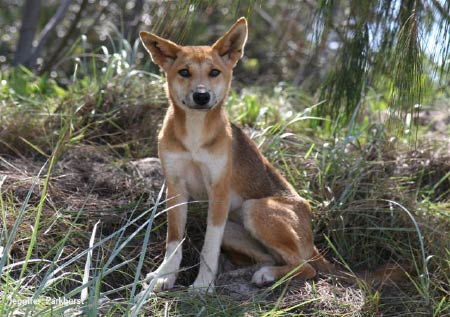 The Dingo is protected in Queensland National Parks as a native species, (Nature Conservation Act 1992) and the State Government has a legal responsibility to conserve these populations and an obligation to ensure that the management of the dingo is ethical and humane.
The Dingo is protected in Queensland National Parks as a native species, (Nature Conservation Act 1992) and the State Government has a legal responsibility to conserve these populations and an obligation to ensure that the management of the dingo is ethical and humane.
This latest project by Qld. National Parks (DERM) of attaching tracking collars to 20 dingoes in the hope of monitoring the animals movements over the Island does not meet the above criteria.
Whilst research is needed scientist’s question the ethics of using such an invasive device and dingo experts believe these collars will be even more detrimental than the ear tags.
It is widely considered by animal behaviourist’s and the scientific community that no surveillance method should be used which is likely to interfere with the animals’ ability to function naturally, but these tracking collars will disrupt normal dingo behaviour, some animals may be ostracized or even killed by other members of the pack, the collars will also interfere with normal foraging and hunting, so how will the data collected be deemed to be accurate?
Tourists and local residents are appalled on seeing these cumbersome collars and there are many doubts as to veracity of this methodology, we ask the Minister Ms.Vicky Darling and Qld National Parks (DERM) the following questions..
What ethics/approvals have been obtained and from where?
What studies have been done to ensure these devices will not interfere with natural behaviours such as hunting, whelping, feeding pups and interacting with other pack members?
What University staff are involved and what are the credentials of those involved in this study?
Sub-adults are mentioned, what is the actual age of the animals collared?
What is the purpose of locating dens? Due to the governments past mistreatment of the animals, this is of great concern to independent researchers and residents.
There is some confusion as to how the release mechanism functions since in the past collars have failed to release. How will those monitoring know when an animal is entangled, unable to hunt or care for pups? Especially since the rangers leave the Island in the evening.
What is the explicit purpose of this research and what is hoped to be achieved?
If the results indicate the dingoes are in crisis, what will be your response?
How do you reconcile the use of these collars with your policy of regarded dingoes as “wild, native animals” that “should be interfered with as little as possible” and of “conserving the species in a near- natural environment?





